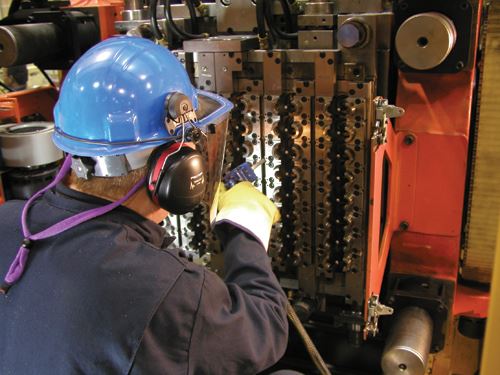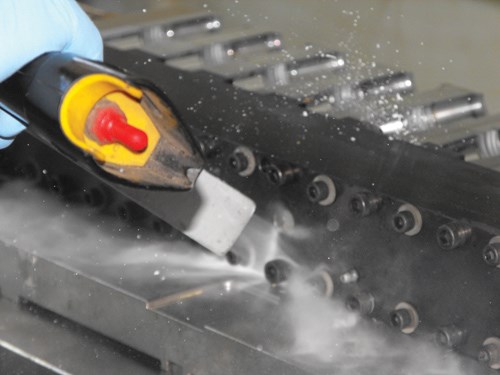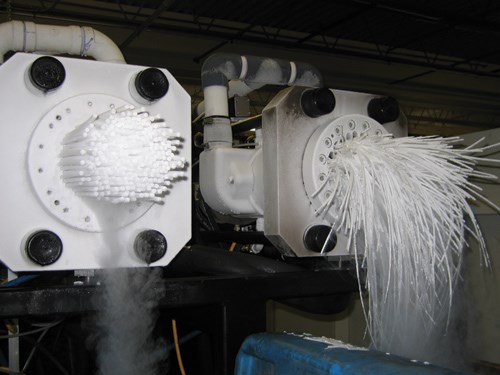Justifying Investment in Cleaning Innovations
The top six benefits of dry ice blasting for injection mold professionals
Few people within the moldmaking industry will argue that cleaning and maintenance are critical processes for maintaining the life and reliability of expensive equipment and ensuring the quality of the end product. Unfortunately, the challenges with cleaning and maintenance are many. Cleaning is tedious and time consuming, particularly with traditional manual cleaning methods. Manufacturers are subject to the demands of the production schedule, so regular scheduled cleaning is often not so regular. To meet the needs of customers, cleaning is often either rushed or postponed, putting both the equipment and the products at risk.
When it comes to cleaning and maintenance challenges, possibly the one that impacts the most companies is justifying new cleaning equipment. Maintenance documentation and record-keeping is still trying to catch up to the modern world, and as a result, many companies do not have a good grasp of the time it takes to clean versus the cost to repair or replace. All aspects and costs associated with cleaning and maintenance, including materials, labor and parts have been lumped together, making it difficult for companies to justify investing in new cleaning innovations—technology that could possibly reduce cleaning time, costs, risks to equipment and scrap rates.
By far the most common cleaning process for cleaning molds is the hands-on method using strong chemical solvents or volatile organic compounds (VOC), scrubbing pads, bottle brushes or emery paper. Even without the chemical solvents, cleaning molds is not a safe process. The biggest challenge for this method is that employees have to work with large, hot, bulky equipment, razor sharp molds and then may be in constant contact with liquid solvents—such as acetones, which are harmful to skin when used regularly over a period of time.
Among the increasingly more popular cleaning innovations being adopted by moldmakers are dry ice blast cleaning systems, which provide an innovative industrial cleaning process that uses recycled CO2 in the form of dry ice media blasted at supersonic speed to remove dirt and other contaminates from the surface to be cleaned. Dry ice particles have a temperature of -109oF. As a result, the combination of the kinetic and thermal effects breaks the bond between the residue and the surface. The residue falls away from the surface and is easily disposed of. The dry ice particles sublimate upon impact, eliminating the added cost and inconvenience of secondary waste treatment and disposal, as well as any downstream contamination. It is a cleaning method similar to sand blasting and other industrial cleaning applications, except that the dry ice is safe, nonabrasive and environmentally responsible.
Below is a list of the top six benefits of dry ice blasting for injection mold/molding professionals:
1. Reduce Costs
Most cleaning practices today involve a multi-step process that requires production to completely stop, and frequently includes a number of people, a variety of cleaners and secondary waste disposal that adds costs to production.
Dry ice blast cleaning reduces labor costs because it can be done quickly by one person and in significantly less time than conventional manual labor. The process also eliminates the need to completely shut-down, cool, disassemble/assemble and relocate equipment for cleaning. A faster, superior clean also delivers increased production and reduced scrap.
2. Improve Quality
Dry ice blast cleaning has proven to be a superior cleaning method for a variety of manufacturing equipment, including bubbler plates, bushings and wear plates, electric motors, injection and blow mold cavities, etc. As mentioned earlier, when coatings are not removed completely from the molds, then product quality suffers and unscheduled downtime is more likely to occur. This downtime delays the entire production process.
While cleaning is critical, using abrasive methods to clean the precision molds can also have a negative impact on product quality. These methods frequently have the reverse effect in that they are often the main reason why residues build up quickly, and they also cause excess wear and flash defects.
3. Improve Productivity
By cleaning equipment in less time, plant managers will be able to get more production cycles from their existing equipment. Dry ice blast cleaning helps to reduce prolonged shut-down times, as equipment can be cleaned while hot and online. In fact, in many instances, dry ice blasting is more effective when the molds are warm. Effective preventive maintenance or spot cleaning can also be done more frequently without impacting production.
4. Prolong Life of Equipment and Molds
Dry ice blasting is a dry process that is also non-abrasive, non-flammable and non-conductive, meaning it won’t damage equipment and can be used safely on most surfaces, including electrical components. The nozzles used in dry ice blast cleaning systems come in a variety of shapes and sizes, which allows operators to access tight and confined areas, providing a more complete clean, and enhancing the quality and precision necessary when cleaning all size components.
5. Improve Worker Safety
Dry ice blast cleaning eliminates exposure to VOCs and the need to work closely with hot equipment. The process also eliminates repetitive motions of hand cleaning or scrubbing, chiseling or activities that require pounding, sanding or scraping. Leading dry ice blasting systems have ergonomic designs that reduce physical stress on workers, including carpal tunnel and other adverse impacts caused by manual processes.
6. Support Environmental Initiatives
Dry ice blast cleaning makes productive use of otherwise unproductive CO2. The process eliminates the need to use VOCs, as well as water in the cleaning process. Traditional cleaning processes, as well as ultrasonic and other media blasting methods, require the proper disposal of toxic waste (towels, cleansers, contaminated water, etc.). Dry ice blast cleaning does not produce secondary waste and helps to eliminate downstream contamination.
Conclusion
While demands on production continue to increase, cleaning technology that can be used to reduce downtime and cleaning times—as well as risks to equipment—continue to take a backseat to traditional cleaning methods. While many may blame the lack of adoption on the current economic condition, the reality is it is difficult to change cleaning cultures, especially within organizations that continue to gamble with production quality by using molds that have not been properly maintained.
Dry ice blast cleaning has proven in numerous manufacturing environments to clean faster, safer and more effectively than traditional cleaning applications. Taking advantage of this innovative cleaning technology will help moldmaking professionals to consistently produce high quality results while also extending the life of their most valuable and expensive pieces of equipment. Most importantly, the ability to clean quickly and in less time allows companies to reduce the costs and environmental impact of secondary waste and getting back to making products and growing the bottom line.
Related Content
Machine Hammer Peening Automates Mold Polishing
A polishing automation solution eliminates hand work, accelerates milling operations and controls surface geometries.
Read MoreMaking Quick and Easy Kaizen Work for Your Shop
Within each person is unlimited creative potential to improve shop operations.
Read MoreHands-on Workshop Teaches Mold Maintenance Process
Intensive workshop teaches the process of mold maintenance to help put an end to the firefighting culture of many toolrooms.
Read MoreThe Role of Social Media in Manufacturing
Charles Daniels CFO of Wepco Plastics shares insights on the role of social media in manufacturing, how to improve the “business” side of a small mold shop and continually developing culture.
Read MoreRead Next
Reasons to Use Fiber Lasers for Mold Cleaning
Fiber lasers offer a simplicity, speed, control and portability, minimizing mold cleaning risks.
Read MoreHow to Use Strategic Planning Tools, Data to Manage the Human Side of Business
Q&A with Marion Wells, MMT EAB member and founder of Human Asset Management.
Read More












.jpg;maxWidth=300;quality=90)





_300x250 3.png;maxWidth=300;quality=90)


.png;maxWidth=300;quality=90)










